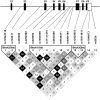Tagging single nucleotide polymorphisms in the IRF1 and IRF8 genes and tuberculosis susceptibility
- PMID: 22879909
- PMCID: PMC3412841
- DOI: 10.1371/journal.pone.0042104
Tagging single nucleotide polymorphisms in the IRF1 and IRF8 genes and tuberculosis susceptibility
Abstract
Genes encoding IRF1 and IRF8 protein have been proposed as candidate tuberculosis susceptibility genes. In order to elucidate whether the IRF1 and IRF8 variants were associated with tuberculosis susceptibility, we conducted a case-control study consisting of 495 controls and 452 ethnically matched cases with tuberculosis in a Chinese population. Seven haplotype tagging single-nucleotide polymorphisms (tagSNPs) (rs2057656; rs2706381; rs2070724; rs2070721; rs2549008; rs2549007; rs2706386) from HapMap database were analyzed, which provided an almost complete coverage of the genetic variations in the IRF1 gene. Fifteen tagSNPs (rs12924316; rs182511; rs305080; rs2292980; rs925994; rs424971; rs16939967; rs11117415; rs4843860; rs9926411; rs8064189; rs12929551; rs10514611; rs1044873; rs6638) were observed in the IRF8 gene. All these tagSNPs were genotyped by SNPstream genotyping and SNaPshot typing. None of the seven tagSNPs was individually associated with tuberculosis in the IRF1 gene. In the IRF8 gene, interestingly, we found that three tagSNPs (rs925994 and rs11117415 located in the intron region; rs10514611 located in the 3'UTR) were associated with risk of tuberculosis after Bonferroni correction. Per allele OR was 1.75 (95% CI 1.35 ~ 2.27, P = 0.002), 4.75 (95% CI 2.16 ~ 10.43, P = 0.002) and 3.39 (95% CI 1.60 ~ 7.20, P = 0.015) respectively. Luciferase reporter gene assay showed that the construct that contained the non-risk allele C of rs10514611 showed significantly higher luciferase activity than did the risk T allele (P<0.01), which implied rs10514611 was a potential functional SNP site. Our results indicated that the IRF8 gene might participate in genetic susceptibility to tuberculosis in a Chinese population.
Conflict of interest statement
Figures



Similar articles
-
Mapping of the IRF8 gene identifies a 3'UTR variant associated with risk of chronic lymphocytic leukemia but not other common non-Hodgkin lymphoma subtypes.Cancer Epidemiol Biomarkers Prev. 2013 Mar;22(3):461-6. doi: 10.1158/1055-9965.EPI-12-1217. Epub 2013 Jan 10. Cancer Epidemiol Biomarkers Prev. 2013. PMID: 23307532 Free PMC article.
-
Association of a functional polymorphism in the 3'-untranslated region of SPI1 with systemic lupus erythematosus.Arthritis Rheum. 2011 Mar;63(3):755-63. doi: 10.1002/art.30188. Arthritis Rheum. 2011. PMID: 21360505
-
Coronary heart disease in systemic lupus erythematosus is associated with interferon regulatory factor-8 gene variants.Circ Cardiovasc Genet. 2013 Jun;6(3):255-63. doi: 10.1161/CIRCGENETICS.113.000044. Epub 2013 May 9. Circ Cardiovasc Genet. 2013. PMID: 23661672
-
Association of SOX11 Polymorphisms in distal 3'UTR with Susceptibility for Schizophrenia.J Clin Lab Anal. 2020 Aug;34(8):e23306. doi: 10.1002/jcla.23306. Epub 2020 Mar 23. J Clin Lab Anal. 2020. PMID: 32207210 Free PMC article.
-
Genetic determinants of susceptibility to Mycobacterial infections: IRF8, a new kid on the block.Adv Exp Med Biol. 2013;783:45-80. doi: 10.1007/978-1-4614-6111-1_3. Adv Exp Med Biol. 2013. PMID: 23468103 Review.
Cited by
-
Five known tagging DLL3 SNPs are not associated with congenital scoliosis: A case-control association study in a Chinese Han population.Medicine (Baltimore). 2016 Jul;95(30):e4347. doi: 10.1097/MD.0000000000004347. Medicine (Baltimore). 2016. PMID: 27472720 Free PMC article.
-
Myeloid Growth Factors Promote Resistance to Mycobacterial Infection by Curtailing Granuloma Necrosis through Macrophage Replenishment.Cell Host Microbe. 2015 Jul 8;18(1):15-26. doi: 10.1016/j.chom.2015.06.008. Cell Host Microbe. 2015. PMID: 26159717 Free PMC article.
-
Genetic and epigenetic changes in host ABCB1 influences malaria susceptibility to Plasmodium falciparum.PLoS One. 2017 Apr 19;12(4):e0175702. doi: 10.1371/journal.pone.0175702. eCollection 2017. PLoS One. 2017. PMID: 28422980 Free PMC article.
-
IRF8: Mechanism of Action and Health Implications.Cells. 2022 Aug 24;11(17):2630. doi: 10.3390/cells11172630. Cells. 2022. PMID: 36078039 Free PMC article. Review.
-
Direct Inhibition of IRF-Dependent Transcriptional Regulatory Mechanisms Associated With Disease.Front Immunol. 2019 May 24;10:1176. doi: 10.3389/fimmu.2019.01176. eCollection 2019. Front Immunol. 2019. PMID: 31178872 Free PMC article. Review.
References
-
- World Health Organization (2009) Global tuberculosis control: epidemiology, strategy, financing, WHO Report 2009. WHO Geneva.
-
- van der Eijk EA, van de Vosse E, Vandenbroucke JP, van Dissel JT (2007) Heredity versus environment in tuberculosis in twins: the 1950s United Kingdom Prophit Survey Simonds and Comstock revisited. Am J Respir Cirt Care Med 176: 1281–1288. - PubMed
-
- Stead WW, Senner JW, Reddick WT, Lofgren JP (1990) Racial differences in susceptibility to infection by Mycobacterium tuberculosis. N Eng J Med 322: 422–427. - PubMed
-
- Casanova JL, Abel L (2002) Genetic dissection of immunity to mycobacteria: the human model. Annu Rev Immunol 20: 581–620. - PubMed
-
- Bellamy R (2003) Susceptibility to mycobacterial infections: the importance of host genetics. Genes Immun 4: 4–11. - PubMed
Publication types
MeSH terms
Substances
LinkOut - more resources
Full Text Sources
Medical

